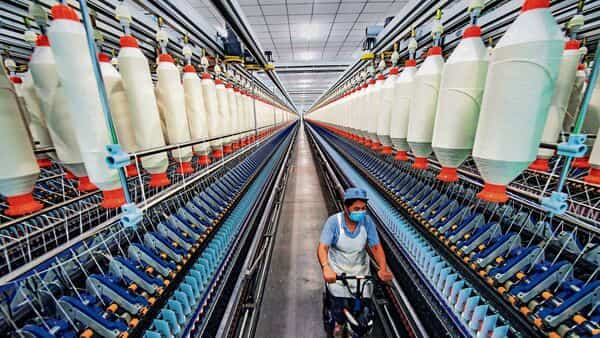[ad_1]
The Indian textile sector faced a rough patch in 2022. A triple whammy of elevated raw material prices, lower exports demand due to the Russia-Ukraine war, and subdued capacity utilization eroded their margins. The situation worsened for spinners, with domestic cotton prices trading at a huge premium compared to international ones, making Indian cotton products uncompetitive globally.
Little wonder then that textile stocks have been beaten black and blue. For instance, in 2022, so far, midcap textile stocks, such as Vardhman Textiles Ltd and Trident Ltd, have corrected by 29% and 37%, respectively. Smallcaps, such as Indo Count Industries Ltd, bore a higher brunt falling around 47% in the period.

View Full Image
Of course, midcaps and smallcaps tend to see a steeper decline than largecaps during a market correction. However, for this sector, near-term headwinds persist, which has also weighed on their stock performances. “H1FY23 has been a turbulent period for the Indian textile value chain owing to spiralling domestic cotton prices and retailers, globally, saddled with excess inventory,” said ICICI Direct Research report. According to the research house, higher inventory levels of global retailers compared to earlier quarters is likely to hit the order book of Indian exporters during the holiday season (Q3FY23) and spring-summer (Q4FY23/Q1FY24).
As things stand, the demand scenario appears bleak owing to a looming global recession. But investors can take some comfort from the fact that the supply side scenario is improving. Cotton prices in India have corrected from ~ ₹1 lakh per candy to ~ ₹70,000. International cotton futures are down ~50%. Thanks to better rainfall, the increase in cotton production in the upcoming season should normalize the supply-side situation and ease the price differential between domestic and international cotton prices. According to analysts at Emkay Global Financial Services Ltd, the last five-year differential averaged at ~5% compared to more than 25% now. “Even in a slightly low-demand scenario, this differential decrease will bring relief to the Indian exporters, especially spinners,” they said in a report.
However, India is at a disadvantage compared to Asian exporting peers due to additional tariffs. “When a Bangladeshi or a Pakistani firm exports a textile product to the EU, they are selling it without any import duty. But an Indian player pays up to 9.5% duty. Bangladesh and Pakistan are better placed in terms of labour cost as well,” said Anuj Jain, research head and co-founder at portfolio management service Green Portfolio.
That said, the increased adoption of a China-plus-one strategy by global companies should aid the sector’s long-term outlook. China+1 strategy means reducing concentration risk in China by diversifying businesses in other countries.
As this further plays out, expectations are that the textile market share globally will move away from China, the world’s largest textile exporter, to key exporting countries such as India, Bangladesh, Pakistan and Vietnam. Global trade of textiles stands at $1 trillion per annum. At $350 billion, China commands 35% of global trade, while India is at 4%. Even if 1% of business moves from China to India, it means the Indian textile industry will double from here,” he said.
Investors in textile stocks will want to keep an eye on the finalization of free trade agreements (FTAs) with the European Union and the UK. FTAs with the UAE and Australia are already done.
One of the benefits of FTAs is that they help reduce tariffs for exporting goods to a trading partner nation. Clearly, a delay in finalizing the FTAs will dampen sentiments.
Know your inner investor
Do you have the nerves of steel or do you get insomniac over your investments? Let’s define your investment approach.
Take the test
Download The Mint News App to get Daily Market Updates.
More
Less
[ad_2]
Source link








